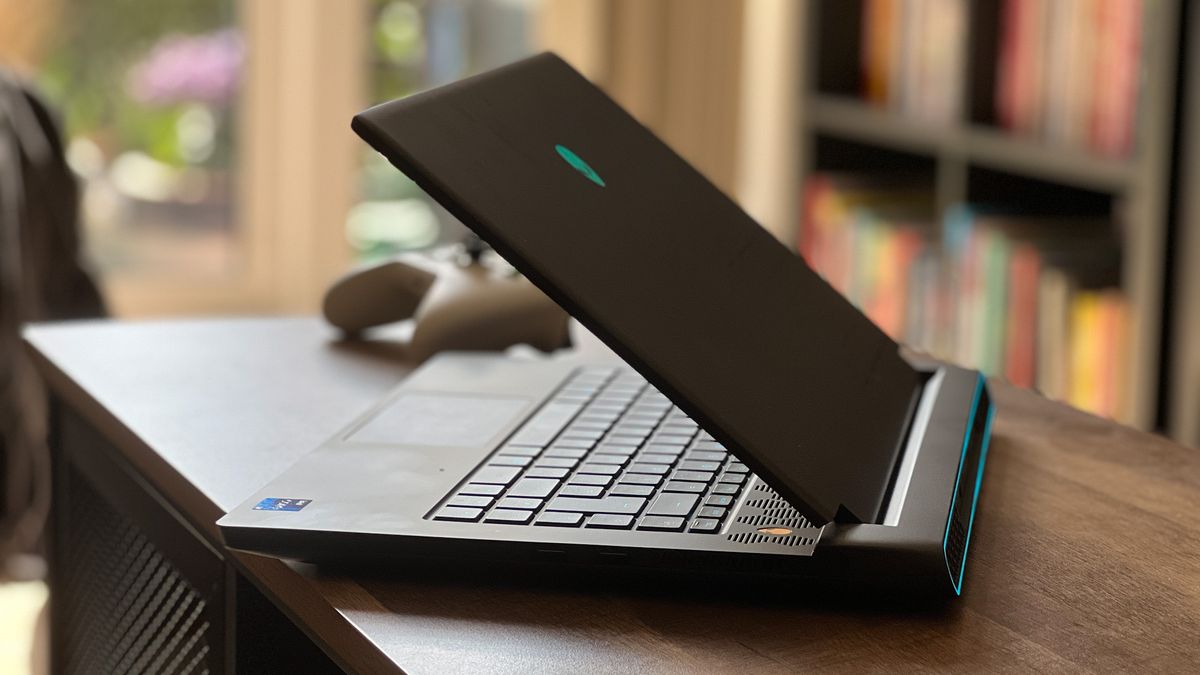GamesRadar+ Verdict
The Alienware M15 R7 is a beast. While you're sacrificing a more luxurious form factor and picking up a set of fans that could rival a stadium, the latest in Alienware's mid-range lineup posts numbers that can't be argued with, and the display looks great while doing so. Be warned, though: this isn't a machine you'll want to sling in a backpack any time soon.
Pros
- +
Incredible performance
- +
Satisfying keyboard
- +
Fast display
- +
Some premium design features
Cons
- -
Cheaper plastic body
- -
Difficult to transport
- -
Particularly loud fans
Why you can trust GamesRadar+
The Alienware M15 R7 has taken root on the shelves, set to replace the M5 / M6 model within Dell's remit of mid-range gaming laptops. It's got some heavy boots to fill - the previous generation was widely regarded as one of the best gaming laptop options on the market, thanks to their affordable design considerations and focus on performance over fancier features.
With Intel's latest 12th generation processors and more space for RTX 3070 Ti and RTX 3080 Ti graphics cards, the R7 has come to bring the Alienware M15 experience we all know and love up to 2022's standards. We put this latest iteration through its paces through two weeks of intensive work and play.
Design
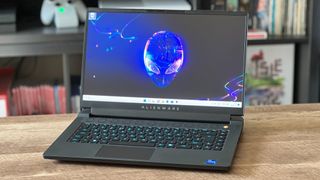
The Alienware M15 R7 carries the same design language as the previous generation, with its plastic body and heavier profile. Dell prioritizes component value in these machines, so you do lose some of the more durable build qualities of the X-range - the Alienware x14, for example, offers a luxury aluminium and magnesium chassis but does drop your power level considerably for it. That means the R7 doesn't feel quite as solid as these more premium devices, but if you're not planning on taking it anywhere with you you'll appreciate that sturdy weight.
If you are looking for a portable machine, though, this isn't it. The Alienware M15 R7 weighs in at just under 6lbs, and comes with an absolutely monstrous power adapter to boot. This thing is huge and takes up considerable backpack space as a result. Of course, there's a lot going on under the hood here, and the R7 needs all the juice it can get, but seriously - this brick is a blight.
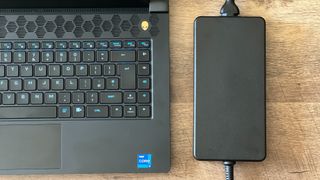
You're still getting the classic Alienware RGB logo on the back, and the super slick RGB strip surrounding the ports as well. Similarly, hexagonal vents still line the bezel above the keyboard. Our review unit came in Dark Side of the Moon - again, another fancy way of saying black, and in a matte finish that felt particularly pleasing under the hand. I was impressed with this material's ability to evade lasting fingerprints, though dust does show up as soon as it lands.
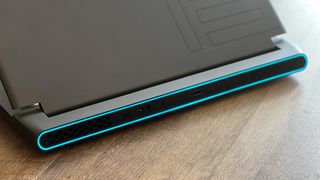
The plastic carriage doesn't really concern me; this is a luxury brand and if we have to drop down a few build pegs to bring the best Alienware laptops to a reasonable figure then it's a sacrifice I'm happy to make. However, while these are cheap for Alienware, they're certainly not budget-minded rigs. Considering the Asus TUF Dash F15 rarely gets close to the M15 R7's starting prices, and offers a more metal chassis, the plastic design does feel a little cheap when set against the wider market. That's especially true considering there's a significant amount of screen wobble and flexing to be found here, though the hinge does feel durable in itself.
Features
Processor: Intel Core i7-12700H
Graphics: Nvidia GeForce RTX 3070 Ti
Memory: 32GB LPDDR5 RAM
Display: 15.6-inch, 360Hz
Resolution: 1920 x 1080 (Full HD)
Storage: 1TB PCIe NVMe M.2 SSD
Ports: 1x USB Type-A 3.2 Gen 1 5Gbps, 1x USB Type-A 3.2 Gen 1, 1x USB Type-A 3.2 Gen 1 5Gbps Port with Powershare, 1x Type-C port with Thunderbolt 4, USB 3.2 Gen 2, DisplayPort 1.4, and Power Delivery, 1x HDMI 2.1, 1x RJ-45 Killer E3100 2.5Gbps Ethernet port, 1x 3.5mm headset jack
Connectivity: Killer Wi-Fi 6 and Bluetooth 5.2
OS: Windows 11 Home 64-bit
Weight: 5.93 lbs (2.69 kg)
If you're looking for an all-in-one machine with no functionality sacrifices, the Alienware M15 R7 certainly isn't going to disappoint. Packing three USB-Type A 3.2 Gen 1 ports (one capable of 5Gbps, and another built with Powershare on top), a Type-C with Thunderbolt 4 and Power Delivery), and an HDMI 2.1, you're covered for the latest generation connections here. Not only that but the majority of these ports are located on the back, so anyone with the cable management woes that I do will be greatly appreciative.
I was also particularly taken with the mSeries keyboard. Boasting a slightly taller 1.8mm travel distance, and a distinctly tactile snap, this is a great feeling set of keys. Rather than the skinny butterfly keyboards we're used to, this is a satisfying experience that makes both gaming and typing comfortable and snappy. A smaller trackpad didn't get in the way of any work and was responsive during my use as well.
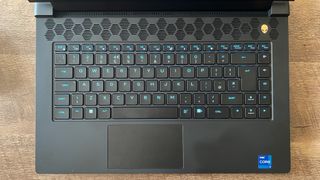
You're getting a set of two stereo speakers here, offering particularly crisp audio with plenty of volume (which you'll certainly need if you're not employing one of the best gaming headsets - but more on that later). Plus, there's a 360Hz Full HD display up top which proved particularly efficient in its motion handling and tear-reduction during my testing. While lighter colors did appear a little washed out, compared to the rich darks on offer, this matte display performs well even under the stress of full daylight.
For the record, you're also getting a 720p webcam built into the top bezel, which was nice for everyday work calls in a pinch but by no means something I'd be swapping in over a dedicated webcam.
Performance
Fire Strike: 24,894
Time Spy: 10,722
PC Mark 10: 7,623
Cinebench: (Multi) - 15,897
Crystal Disk Mark: 6501.56 MB/s read; 5705.88 MB/s write
The Division 2: High - 124fps; Ultra - 97fps
Metro Exodus: High - 98fps; RTX - 72fps
Red Dead Redemption 2: High - 79fps; Ultra - 76fps
Total War: Three Kingdoms: High - 120fps; Ultra - 83fps
Shadow of the Tomb Raider: High - 148fps; Highest - 129fps
This is where your sacrifices in building materials pay off. The Alienware M15 R7 can fly. With our test unit's i7-12700H processor and RTX 3070 Ti GPU, we were easily benching well over 60fps on the highest settings across all titles played. Even stress testing this system with a heavy Red Dead Redemption 2 run still yielded incredible results - 76fps on average with Ultra textures and every slider set to max. That's the kind of performance that bests even the RTX 3080 Ti Razer Blade 15, with an i9 processor at the helm no less.
Fire Strike GPU scores also beat out last year's M5 model, with an incredible 24,894 score offering up significant advantages over the 22,883 figure supplied by an RTX 3080 build of the previous generation. Not only that, but this CPU can certainly keep up. That 7,623 PC Mark 10 score and 15,897 Cinebench core score both easily pitch this machine among the most powerful on the market. In practice, that translates as super slick performance across both productivity and gaming. This rig didn't bat an eye at even my heaviest Cities Skylines save files, or a densely packed Planet Coaster map.
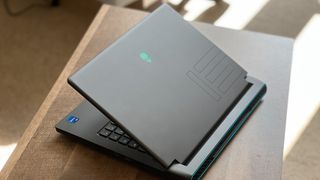
Faster action titles ran without a hitch, with that 360Hz refresh rate display acting as the cherry on the stunningly powerful cake. Everything was gliding across the screen, more action-packed sequences never caused stutters or fragmentation, and I never felt like the M7 was working to catch up with itself. The on-screen performance was flawless... with headphones.
All that power needs to come from somewhere, and supplying all these incredible figures is a set of components that need to keep cool. The fans employed for this job love to make a racket. This is, without doubt, one of the loudest gaming laptops I've ever fired up, with fans revving up to deafening volumes at the drop of a hat. I was sometimes sat on Windows 11 settings menus, only for the fans to kick in at full pelt for seemingly no reason.
Of course, that's how you're getting such good performance. There was only ever some minor thermal throttling in this CPU when pushed to its hardcore rendering limits, and, in general, everything stayed admirably cool. Fan noise on a gaming laptop is a small price to pay for a comfortable and still extremely smooth experience.
Should you buy the Alienware M15 R7
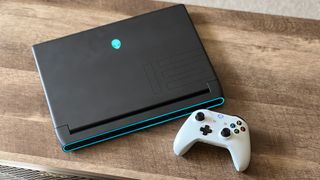
The Alienware M15 R7 is a certified powerhouse, and if you're married to this brand's expert engineering and unique aesthetic, it's the best value for money within the current range. We'd also recommend anyone on the lookout for the latest 12th generation Intel processors and a Ti version of Nvidia's latest GPUs check out the seriously monstrous performance on offer here - this R7 really does draw the best out of these components. Still, with our configuration coming in at over $2,000 / £2,000, the M15 R7 isn't going to be for everyone.
Those after a cheap Alienware laptop may be better off dropping down a notch and taking aim at the previous generation Alienware M15 R5 while it's still around. Prices on this machine are falling particularly quickly right now, with base configurations even knocking on the $1,000 / £1,000 door.
If you're going for pure component value at the lowest price worth paying, we'd recommend taking a look at the Acer Nitro 5. You can configure these rigs up to 12th generation Intel processors now, and you've still got Ti options open to you.
How we tested the Alienware M15 R7
I used the Alienware M15 R7 as my daily driver for everyday gaming and as my work machine for a few days, over a period of two weeks. I completed a full run of Rise of the Tomb Raider, and used Apex Legends, Planet Coaster, and Cities Skylines for casual play, while pushing CPU and GPU to their limits across Red Dead Redemption 2, Metro Exodus, The Division 2, Total War: Three Kingdoms, and Shadow of the Tomb Raider.
We're also rounding up all the best Razer laptops if you're looking to get an eye in on the competition, or check out the latest cheap gaming laptop deals for additional savings.

Managing Editor of Hardware at GamesRadar+, I originally landed in hardware at our sister site TechRadar before moving over to GamesRadar. In between, I've written for Tom’s Guide, Wireframe, The Indie Game Website and That Video Game Blog, covering everything from the PS5 launch to the Apple Pencil. Now, i'm focused on Nintendo Switch, gaming laptops (and the keyboards, headsets and mice that come with them), PS5, and trying to find the perfect projector.

Assassin's Creed Shadows' Japanese setting has been "very, very tricky" because Ubisoft wants to be "respectful" and "avoid telling a culture about their own culture"
Pimax Crystal Light review: "Not the right choice for pickup-and-play VR gaming"
I went into Aloft expecting a Stardew Valley meets Studio Ghibli experience, but I left impressed by its whimsical take on the survival genre instead
Most Popular


